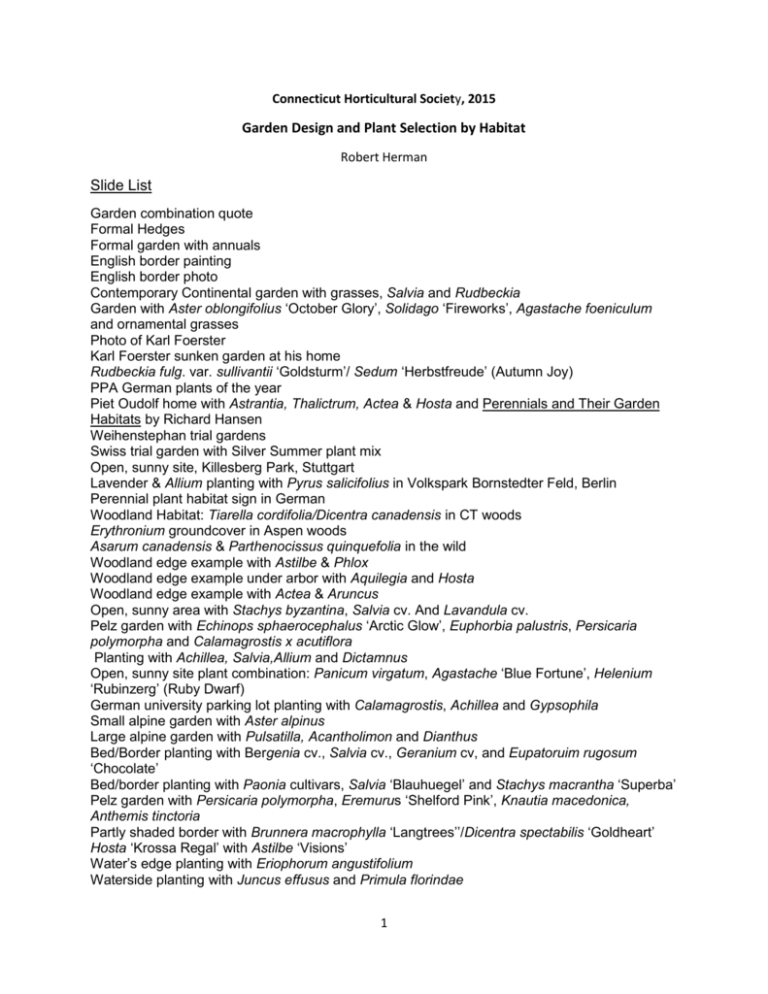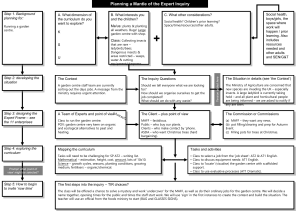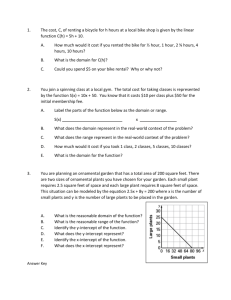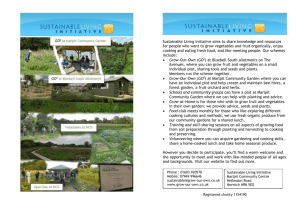CT Hort Society 2015 Slide List Handout RH
advertisement

Connecticut Horticultural Society, 2015 Garden Design and Plant Selection by Habitat Robert Herman Slide List Garden combination quote Formal Hedges Formal garden with annuals English border painting English border photo Contemporary Continental garden with grasses, Salvia and Rudbeckia Garden with Aster oblongifolius ‘October Glory’, Solidago ‘Fireworks’, Agastache foeniculum and ornamental grasses Photo of Karl Foerster Karl Foerster sunken garden at his home Rudbeckia fulg. var. sullivantii ‘Goldsturm’/ Sedum ‘Herbstfreude’ (Autumn Joy) PPA German plants of the year Piet Oudolf home with Astrantia, Thalictrum, Actea & Hosta and Perennials and Their Garden Habitats by Richard Hansen Weihenstephan trial gardens Swiss trial garden with Silver Summer plant mix Open, sunny site, Killesberg Park, Stuttgart Lavender & Allium planting with Pyrus salicifolius in Volkspark Bornstedter Feld, Berlin Perennial plant habitat sign in German Woodland Habitat: Tiarella cordifolia/Dicentra canadensis in CT woods Erythronium groundcover in Aspen woods Asarum canadensis & Parthenocissus quinquefolia in the wild Woodland edge example with Astilbe & Phlox Woodland edge example under arbor with Aquilegia and Hosta Woodland edge example with Actea & Aruncus Open, sunny area with Stachys byzantina, Salvia cv. And Lavandula cv. Pelz garden with Echinops sphaerocephalus ‘Arctic Glow’, Euphorbia palustris, Persicaria polymorpha and Calamagrostis x acutiflora Planting with Achillea, Salvia,Allium and Dictamnus Open, sunny site plant combination: Panicum virgatum, Agastache ‘Blue Fortune’, Helenium ‘Rubinzerg’ (Ruby Dwarf) German university parking lot planting with Calamagrostis, Achillea and Gypsophila Small alpine garden with Aster alpinus Large alpine garden with Pulsatilla, Acantholimon and Dianthus Bed/Border planting with Bergenia cv., Salvia cv., Geranium cv, and Eupatoruim rugosum ‘Chocolate’ Bed/border planting with Paonia cultivars, Salvia ‘Blauhuegel’ and Stachys macrantha ‘Superba’ Pelz garden with Persicaria polymorpha, Eremurus ‘Shelford Pink’, Knautia macedonica, Anthemis tinctoria Partly shaded border with Brunnera macrophylla ‘Langtrees’’/Dicentra spectabilis ‘Goldheart’ Hosta ‘Krossa Regal’ with Astilbe ‘Visions’ Water’s edge planting with Eriophorum angustifolium Waterside planting with Juncus effusus and Primula florindae 1 Caltha palustris at water’s edge Nymphaea cv. in pond Noel Kingsbury quote Cassian Schmidt of Hermanshof in Weinheim, Germany studying plant communities Natural meadow Cape Cod landscape Hermanshof, Weinheim, Germany - Dry prairie planting with Stipa (Nasella) tenuissima, Echinacea paradoxa and Asclepias tuberosa Dry prairie planting in fall, with Stipa (Nasella) tenuissima, Amorpha canescens and Echinacea simulata Open, sunny parking area at German university – bring the natural world into an urban or suburban environment U.S. Parking lot with Calamagrostis x acutiflora ‘Karl Foerster’ and Rudbeckia ‘Goldsturm’ Alchemilla mollis/ Euphorbia amygdaloides var. robbiae/ Epimedium – low maintenance Zurich Botanical Garden – work with what you’ve got Panicum virgatum, Agastache foeniculum, Helenium ‘Ruby Dwarf’ – robust, pest-resistant plants Molinia caerulea ‘Variegata’/Persicaria amplexicaule/Rudbeckia fulgida/Eupatorium purpureum in moist, sunny ‘area at Beth Chatto’s Garden – tolerant, adaptable, disease-resistant plants Sedum ‘Matrona and Eryngium planum cv.- compact plants Helenium ‘Kupferzwerg’ (Copper Dwarf), Aster amellus – compact plants Salvia nemorosa ‘Blauhügel’/ Achnatherum calamagrostis/ Achillea ‘Schwellenburg’ – compact plants North American plant community – Tiarella, Camassia and woody plants coexist harmoniously, create a “natural“ ecosystem North American plant community combinations – Monarda bradburniana and Heliopsis helianthoides (‘Prairie Sunset’-like) German-style ecological planting design Hermanshof: Overview of gardens in spring Overview of gardens in early summer Section of gardens in mid-summer Section of gardens in fall Overview of gardens in late fall Piet Oudolf garden in fall R. Herman www.plantsman.us 2 Richard Hansen Concept - Garden Design by Habitat A German ecological approach to combining perennials based on universal plant habitats. Plants from all over the world are classified according to their ideal growing situation. The major categories are: 1. 2. 3. 4. 5. 6. 7. Woodland - partially shaded, soil high in humus Woodland Edge - south side sunny and warm; north side shady and cool Open, Sunny Area Alpine or Rock Garden Bed or Border, sunny or partly shaded (primarily large, decorative plants) Water’s Edge and Marsh Water (able to grow in water) Why consider planting a perennial garden that is based on habitat? To maintain the natural environment To bring the feeling of a natural world to an urban or suburban environment To create a family garden – an outdoor classroom To reduce maintenance To minimize use of chemicals To have a successful garden Guidelines Based on Plant Communities and Proper Habitats Work with what you’ve got Choose plants that thrive in the given conditions Select plants that are: 1. tolerant and adaptable 2. disease-resistant 3. compact or strong-stemmed 4. similar in rate of growth or competitiveness Strive for a natural design style – observe and imitate nature Use plants that co-exist harmoniously together, creating your own version of a natural ecosystem Some additional design points I did not cover in this lecture Forget the English "class picture" effect - allow for a natural variation in heights Plant in large numbers or swaths Let groups "flow" into and around one another Let plants self-sow and weed selectively Plan for year-round interest 3 Resources for Habitat Garden Planning: Perennials and Their Garden Habitats by Hansen/Stahl Timber Press, 1993 – out of print The New Perennial Garden by Noël Kingsbury Frances Lincoln Limited, 1996 (hard and soft cover editions) Hansen Design Premises: ONE: The "leading”, or “dominant," plants provide the starting point for the planting. They maintain a sense of order; without them, a bed or border design cannot be successful. They are organized in a rhythmical succession to maintain cohesiveness in the design. TWO: In order for a garden's conception to come alive and create interest, the varying plant heights should establish different levels, changing and providing a kind of “give and take” between each group. For example, lower perennials are planted in groups that start at the front of the garden and "flow" to the back, surrounding the middle-sized and tall plants so that they seem to step forward or retreat. This creates stimulating optical “crossroads”, or meeting points, and, at the same time, surprises one with details that become apparent as the viewpoint changes. THREE: Another method to establish a similar result is to place taller plants, singly or in small groups, within a planting of low, ground-covering perennials. The goal is to create a contrast between tall and low plants which can be further enhanced by changes in flower colors and blooming periods. 4








